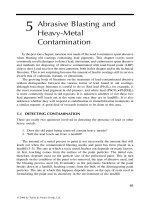The bio control handbook second edition
Bạn đang xem bản rút gọn của tài liệu. Xem và tải ngay bản đầy đủ của tài liệu tại đây (18.56 MB, 63 trang )
Processes and
Applications of
Commercially Available
Bio-Control Agents.
by
The Bio-Control
Second
Editio
Handbook
Table of Contents
Introduction p.3
Second Edition Forward p.4
Chapter 1 - Anystis baccarum p.5 - p.9
Chapter 2 - Aphid Control p.10-p.21
Aphidoletes p.13 - p. 15
Brown Lacewing p.16 - p.18
Chapter 5 - Thrips Control p.44 - p.49
Hoverfly p.19 - p.21
Chapter 3 - Whitefly Control p.22 - p.31
Encarsia p.25 - p.27
Delphastus p.28 - p.30
Chapter 4 - Spider Mite Control p.32 - p.43
Fallacis p.35 - p.37
Stethorus p.38 - 40
Persimilis p.41 - p.43
Cucumeris p.47 - p.49
Chapter 6 - Fungus Gnat and Soil Pest Control
p.50 - p.61
Stratiolaelaps p.53 - p.55
Gaeolaelaps p.56 - p.58
Dalotia p.59 - p.61
General Rates Guide p.62
Acknowledgments p.63
Introduction
The Bio-Control Handbook presented by Applied Bio-Nomics Ltd is an essential text for
commercial growers and scouts and is useful for anyone responsible for the success of a plant or
crop.
The following processes and applications for use of our bio-control agents only apply to our
products. The same species from different producers will have different rates and ranges due to
how they are reared, stored and shipped. If using bio-controls from another company, refer to
their strategies.
This guide is meant to supplement an established bio-control program.
Should you just be starting down this road of alternatives to chemical bio-control, contact us or
your local bio-control distributor for information on getting started.
Our website is a more complete source of information:
www.appliedbio-nomics.com
Forward for the Second Edition
A typical bio-control publication will date itself with reference to obsolete and unavailable
pesticides. Fortunately, the bio-control program encouraged by Applied Bio-nomics Ltd.
recognizes that while some bio-control agents will survive some chemical treatments, a
purely chemical free approach benefits the applied bio-control agents and encourages the
arrival of native contributors. Therefore, you will find few changes from the First Edition,
other than the massively influential addition of the new bio-control agent: Anystis baccarum
(The Crazee Mite).
The common foliar pests discussed in this handbook are all harassed, consumed and
sometimes outright eliminated by the Crazee mite. Additionally, it can control other pests
that have often eluded control by traditional bio-control agents; most important of those
being echinothrips and mealybugs. Thus, the Crazee Mite warrants discussion on its own.
However, the strategies discussed for controlling the common greenhouse pests prior to the
introduction of the Crazee Mite are still relevant and in many cases preferable both in cost
and efficacy. Therefore, this Second Edition will begin with an introduction to Anystis
baccarum and what you can expect from it, but leave the existing strategies in place.
CHAPTER 1
The Crazee Mite - Anystis baccarum
Ch. 1
The Crazee Mite - Anystis baccarum
A
nystis baccarum is a cosmopolitan predatory mite with
populations throughout North America, Europe and
Asia. It has long been recognized as an effective
predator of the European Red Mite in orchards and is known to
control various other pests in natural settings.
However, attempts to mass produce and commercialize Anystis
species have been thwarted by their voracious appetite and
tendency to cannibalize with a lack of food. But with the
combined research and development with Applied Bio-nomics
Ltd. and Vineland Research and Innovation Centre this
breakthrough has allowed for growers to try Anystis baccarum
as a substitute or addition to regular bio-control programs.
These mites are easy to scout and have quickly become
favoured by most growers who have tried them. Their large
size, hunger, speed and erratic running pattern resulted in their
nickname The Crazee Mite, although some are familiar with
their other name: “whirligig mites.”
Most importantly, their range of prey and compatibility with
other bio-control agents is astonishing. They can be added in
addition to all strategies and products listed in this handbook,
and can also stand alone in some circumstances.
As with all new bio-control agents, research is on-going. Which
pests are truly controlled and in what environments as well as
the limitations of the Crazee Mite are still being determined.
However, as this research continues, the Crazee Mites have
already established themselves as the top thrips predator, an
essential addition to aphid and spider mite control programs
and a welcomed predator of whitefly, mealybugs, echinothrips,
psyllids and more. Growers are welcoming this new bio-control
agent and eager to try it in crops previously controlled
regularly with chemical interventions, like hanging baskets,
calibrachoa, gerbera and succulents.
Anystis baccarum
The Crazee Mite, Anystis baccarum (also known as the
Whirligig Mite) is a cosmopolitan predatory mite found
throughout most of the Northern Hemisphere and in select
areas of the Southern Hemisphere.
It is easily recognizable as being relatively large, extremely fast
and often running in a seemingly erratic pattern. It primarily
feeds on foliar pests and is found most often on undersides of
leaves where pests are present. It notably controls thrips,
aphids and spider mites, but is also a known predator of
echinothrips, mealybugs, psyllids, whitefly, and the European
Red Mite.
Its lifecycle is relatively long.
Eggs hatch into larval
stages and then three
nymph stages before
reaching adult hood 3-4
weeks later. All stages are
predatory and all mites are
female. Eggs will be laid by
Anystis on lemon
adults for three weeks. They
are typically laid in loose growing media and in small clusters
of 15-30 eggs, several times during the adult stage.
Eggs and larval stages are best suited for moist and
consistently warm locations but still develop as low as 10°C.
An adult Crazee Mite
While adults historically cross
exposed concrete at
impressively high
temperatures and are subject
to the natural temperature
swings of high latitude areas,
25°C and 60%RH is close to
their optimum conditions.
Therefore, they are well
suited for both outdoor
applications in gardens and
field crops as well as indoor
applications like nurseries,
house plants, and
greenhouses.
A bag of 1000 adults
Applying Anystis
Shipping: Crazee Mites are shipped in various quantities and
life stages. A package of 1,000 adults is actually shipped as
their last pupal stage so as to emerge as hungry adults upon
receipt. So to is the intention of the adult package of 250. The
250 Eggs quantity is several hundred eggs (to account for
mortality) and emerge as larval stage upon receipt.
Quality Control: All stages of the Anystis baccarum are
mobile. The fastest way to determine fitness of the shipped
population is to watch emerging Crazees over 1-3 days of
receipt. The mites are very fragile, so allow them some time to
choose to move. Once mobile, they should be quick and not
lethargic.
Release: Tub products may remain
as-is to allow voluntary release
from the container. The bag
product may be sprinkled in
desired location. All stages want to
disperse, so central releases are
appropriate, but so too is pouring
out contents in several locations.
Anystis pupa
Scouting: Scouting is famously easy with Crazee Mites, at least
initially. They are relatively large, bright orange or red and run
at incredible speeds. They are sometimes stationary only when
eating, and will be found hidden on undersides of leaves
An adult Anystis eating hop aphids on hops
during this time. Most common they are found running along
exposed surfaces like leaf tops, concrete or greenhouse
structural components. Nymphs and larval stages are smaller
and paler and less likely to be found. Eggs and pupa are often
in growing media or other cryptic locations.
Rates: Because of their searching abilities, speed and
tendency to disperse to find suitable prey, precise rates are
subject to crop, pest and environment. However, the
recommended starting point is 250 mites per 1000 square feet
for prevention and 1,000 mites or more, for the same space
when knock-down is required.
Predators: It is believed spiders are their primary predator.
Anystis at a Glance
Effective Temperature Range: Unknown
Eggs laid per female: 45-150 in three weeks
Egg to Adult: 3 weeks (Another 3 weeks as adult)
Prey eaten per adult: depends on size of prey
Known Predators: Spiders
Targeted Pests and Species: Aphids,
Thrips, Spider mites and European Red
Mite. May control mealybugs, echinothrips,
pysillids and whitefly.
CHAPTER 2
Aphid Control
2
Aphid Control
A
phids cause more costly crop damage than any other
pest. Every grower in the world has encountered
aphids. Resistance to chemical controls, the
restrictions or out-right bans on neonicotinoids, and rapidly
developing bacterial resistance to parasitism has lead experts
to predict that aphids will continue to be the #1 threat to
growers and will continue to get worse.
Unfortunately, aphids are one of the most complicated pests to
control.
Aphids are able to surprise even the most keen-eyed scouts
with their sudden ability to exponentially increase colony size.
Aphids actively defend against predation and receive help
doing so by ants who farm them for their honeydew secretions.
Their rapid draw of phloem and their promotion of molds and
mildew lead to quick plant decline and immediate cosmetic
losses.
Fortunately, aphid ubiquity and proliferation also make them a
reliable food source for a multitude of predators. Some
predators target specific aphid species, while others are more
general in their appetite. Some predators are not beholden to
aphids as their only food source. Aphid parasitoids are
common and commercially available, but naturally-occurring
parasitism resistance has recently made them less suitable for
commercial aphid control, and the mummies created and left
behind are a serious cosmetic concern, especially for
ornamentals.
This chapter will focus on providing quick access to proven,
practical control techniques of aphids. We will address the
nature of aphids, scouting and monitoring techniques,
beneficial cultural practices, our primary aphid predator and
two supplementary predators for special situations.
Aphids
Aphid populations increase rapidly due to
live-birthing pre-fertilized female clones.
High density and other environmental
factors can trigger some aphids to become
alate (grow wings). And extend their
range rapidly. Sexual reproduction and
the production of eggs is much more rare.
Aphids feed on the phloem (or sap) in the
soft tissue of plants. Rapid plant growth
directly correlates with rapid aphid
reproduction. When you can, reduce the
nitrogen content in your fertilizer and
provide calcium-based nitrogen.
Screened air in-takes and entrances restrict aphid infestations. Ultra-violet “bug zappers” may
attract alate aphids. Put a bucket of water below to monitor their populations. Many aphids are
also repelled by specific colours (like silver) and attracted to others (like orange). Colours, along
with the presence of some bio-pesticides are sometimes an additional deterrent from your crop.
Aphidoletes aphidimyza
Aphidoletes aphidimyza is the primary aphid predator for commercial
bio-control. It proliferates and consumes aphids at a rate far greater than
the aphid reproduction cycle. It will persist as long as there are any
aphids, and only once aphids are gone will it turn to other food sources
like whitefly. There are few environmental conditions that limit its use and
therefore there are almost no applications where growers have failed to
control aphids with Aphidoletes.
Aphidoletes is a predatory midge. At the
winged adult stage it seeks out and
feeds on honeydew secreted by
phloem-feeding insects. It lays its
(Three Aphidoletes larva fight over a remaining aphid.)
hundreds of eggs on or near aphids.
Aphidoletes larva are short-lived:
Aphidoletes eggs among aphids
Windspeed must be less than 2mph in order to get the greatest
approximately one week. Each will consume 20 or more aphids during
efficiency in predation. High windspeed
this time, but can kill up to 50 per day. They are only easily visible in the
make all winged-predators ineffective by
last 3 days of their larval stage. Larvae drop to the ground to pupate in
making them unable to fly, or by disrupting
soil. Pupation can take over one week. The cycling of Aphidoletes is
their ability to smell and locate prey. Turn
dependant on a light ratio greater than 13:11 (light to dark).
fans off when releasing Aphidoletes for a
Supplemental light does not need to be intense. Walkway/emergency
minimum of 6 hours.
lighting is often enough.
Like most vermiform predators of the
The temperature range for Aphidoletes when shipped fresh and
Diptera order, Aphidoletes are very
unrefrigerated is 15 Celsius to just over 30, with the optimum range of 21
susceptible to chemical applications.
to 25 Celsius. Below 18C they are often not fast enough to keep up with
Adult female Aphidoletes
some aphid species.
Aphidoletes are not effective against low-temperature foxglove aphid, or
Aphidoletes are not aphid species specific. Like other vermiform (worm
Aphidoletes application rates.
like) predators, Aphidoletes larvae do not elicit aphid defences.
on calibrachoa. Crops of intensely hairy plants often need increased
Applying Aphidoletes
Shipping: Aphidoletes are shipped as pupae, with carefully
measured moisture content. Do not open until time of release.
Holding temperature is best at room temperature.
Quality Control: Wait 24 hours after adults emerge. Make an
estimated count of emergence by utilizing the ribs of the tray as a
grid-system.
Release: Fresh, unrefrigerated
Aphidoletes have full search
capabilities in tact. One release
point per hectare is sufficient.
Screw a pot to the north side of a
central post. Ensure this spot is
protected from water. 24 hours
after adults began to emerge
place the tray in the pot at dusk.
Turn off greenhouse fans for at
least 6 hours. Open the lid.
Alternatively, a hanging vial can be placed in a protected spot in the
crop. The process of hanging opens the vial to emerging adults.
Scouting: At dusk, with fans off, look to see the adult midges flying
in random patterns above the crop. 3-5 days after release, a
microscope or hand-lens may be required to spot eggs or new
larvae. At 5 to 7 days look to existing aphid colonies for Aphidoletes
larvae. Aphidoletes often feed protected under their prey. Gently
brush aside the aphids to reveal the Aphidoletes below.
Aphidoletes will turn yellow when feeding exclusively on whitefly scale.
Ants: Continuously monitor for and control ants. They will remove
the Aphidoletes from aphid colonies.
Rates: Release rates vary. A typical
prevention program entails a
release of 250 A.a. per acre every
week. Typically, to combat an
infestation that rate is increased to
1000 A.a. per acre every week. In
some out door crops, waiting for
aphids to establish, then
introducing 1000 A.a. per acre ontime ensures a season-long cycling of predatory midges. Success
depends on matching the release rate to the aphid population.
Always aim for more in the beginning, so you need less in the end.
Aphidoletes At a Glance
Effective Temperature Range: 15C to 30C
Eggs laid per female: 150-250 in one weeks
Egg to Adult: 1-2 weeks (1 week as predatory larva)
Aphids consumed per larva: 50-200 daily
Prevention Rate:
250-1000 per acre every
week.
Trigger aphid defences: No
Known Predators: Ants and swirskii
Special precautions: Supplemental light; reduced fan speeds.
Targeted Pests and Species:
Reactive Rate: 1,000 to
5,000 in two or more
release points per acre
once per week.
Aphids ( >60 different species) ; Whitefly scale
Micromus variegatus
Our brown lacewing, Micromus variegatus, is also a top aphid
predator. Until now, brown lacewings have garnered little attention
in North America. Part of this is due to the relative fame of its larger
cousin - the green lacewing; but also because, being nocturnal,
they are seldom seen.
What separates the brown lacewing from the green lacewing, and
raises its stature among aphid predators to the liking of beetles and
hoverflies is that it is a voracious predator both in the larval and
adult stage.
The addition of Micromus to our program was
intended to fill two important gaps: 1. To
provide a hungry generalist (they eat aphids,
scale, spider mites, leaf-hoppers, mealybugs
and more) and 2. To provide a cold-season
aphid predator for control in cool crops and
target the foxglove aphid. The lacewing still
actively hunts and feeds down to 4 degrees
Celsius.
There are some applications where Micromus has been successfully
used as the only aphid predator, but it still remains primarily a
supplement to our Aphidoletes program. We have found Micromus
persisting over a year in ornamental greenhouses where it
presumably served as a low-density generalist.
With the successful application of Micromus variegatus, you get
low-level pollination, a clean-up of honeydew, long-range searching
ability, generalist predation, and extreme aphid predation.
Adult brown lacewing, Micromus variegatus.
Micromus variegatus lay eggs singularly near aphids. Larva emerge
after 5-7 days and immediately begin consuming aphids and any
soft-bodied prey by piercing and holding prey in their hollow
mandibles and sucking them dry.
After two weeks as larvae,
consuming hundreds of aphids,
they take to the ground in protected
leaf-litter or under pots to pupate.
Adults emerge one week later.
Under the right circumstances,
adults will live several weeks and lay over one hundred more eggs,
typically lower in the canopy than other predators.
Larva of all lacewing species are cannibalistic when food is scarce
or when densities are too high.
Applying Micromus
Shipping: Our brown lacewings are shipped as adults with a small
amount of “bug food” for transit in
quantities of 50 or 100. There is no “storage
time” for Micromus. They must be released
immediately after one hour of acclimatizing
to release temperature. They are also
available as eggs, ready to hatch into
Micromus weave a delicate cocoon
voracious larva.
Quality Control: Micromus will “play dead” as a defence against
predation. Expect to see many that appear dead in the bottle. 24
hours after release, slowly remove the packing paper, shaking any
adults back into the container. Wait one
more hour then count the dead. Packages
are over-packed by 10 percent to account
for some mortality.
Release: Egg application is easy. Simply
drape the contents in an aphid hot spot
and remove the media 3-7 days later.
Adult lacewing are likely ready to release
when they arrive. Find a protected area
low in a canopy off the ground and
remove the lid. Remove some of the
Release on a hop vine
packing from the bottle to ease adults’
emergence. Reduce fan speeds to allow them to search for aphids.
Because they are most active at night, this is the best time for low
wind speeds.
Two Micromus variegatus larva fight for food.
Scouting: Micromus are attracted to lights at night. If aphid control
is best in night-lighted areas, consider turning off the lights for
more even spread. Adult populations can be
seen when these lights are on. During the
day, look for them under leaves. You may find
larvae, but moving the leaf often results in the
A captured aphid
adults “playing dead” and dropping to the
ground. Look up into the densest part of the canopy without
touching the plants to find adults.
When hungry, adults and larva will also feed during the day. Their
natural predators are birds, so the cast of a shadow from you
walking-by or a spray-boom passing over the crop is often enough
to make lacewings drop from the plant. While this may disrupt their
feeding it is seldom enough to reduce efficacy.
Brown lacewing at a Glance
Effective Temperature Range: 4C to 30C
Eggs laid per female: 100-200 in two or three weeks
Egg to Adult: 3-4 weeks (2 weeks as predatory larva)
Aphids consumed per larva: 5-200 daily
Trigger aphid defences: Yes
Known Predators: Birds
Prevention Rate: 600
adults per hectare in
spring.
Reactive Rate: 100 to
200 adults in a hotspot,
once. Eggs are best for
knock-down.
Special precautions: Reduced fan speeds, especially at night.
Targeted Pests
- Aphids:
- Whitefly:
- Leaf hopper
- Small caterpillars
- Mealybugs
- Other soft-bodies prey
Eupeodes americanus
Eupeodes americanus is the American Hoverfly. Known also as
Flowerflies and syrphid flies, these flies are regular and welcome
predators. Many species, including ours, feed only on pollen and nectar
as adults, but it is the hoverfly larvae that consume aphid colonies.
Like Aphidoletes, hoverfly larvae are
vermiform. This worm-like, or slug-like
form has evolved to be undetectable to
aphids. Thus the predation rate of
Eupeodes americanus larvae out
compete all other predators.
However, because of this intense feeding
An adult hoverfly, Eupeodes americanus
habit, many hoverflies establish naturally
late in the season when aphid populations are at their peak. A
Hoverflies are strong fliers, but still require reduced windspeed to detect
preventative release of hoverflies does not guarantee they will cycle. As
aphids. Eggs are laid singularly next to feeding aphids. The larvae
with our Brown Lacewing, the Hoverfly should only be used as a
emerge and begin feeding immediately for the next 7 days. In the last
supplement to Aphidoletes for aphid control, unless under special
two days (their third instar) each larva will feed on over 100 aphids daily.
circumstances.
Eupeodes americanus is unlikely to
Hoverfly species are the most likely candidates to have any effective
pupate on plant material, but instead,
aphid control in caliberchoa, and research continues. Hoverflies are also
burrow into the soil or pupate under
useful in crops requiring pollination that are subject to aphid infestations,
pots. Pupation lasts approximately one
such as peppers. In these crops, the hoverflies can pollinate and protect.
week.
The adult hoverfly needs 5 days of feeding exclusively on pollen and
The release of hoverflies is a favourite for
nectar before they are ready to lay eggs. Some growers have taken to
release and sale in garden centres, as
releasing the hoverflies in small cages with a potted alyssum and
customers recognize them as beneficial.
allowing them to feed for 5 days before opening the cage for them to fly
They also serve as an excellent example
out. Adults are oviposition-ready from that point until they die 2-3 weeks
for an alternative to the environmentally-
later.
harmful trade of wild ladybugs.
Applying Hoverflies
Shipping: Eupeodes americanus is shipped as pupa in moisturecontrolled media in packages of 50, with an over-pack of 20%.
Quality Control: After all adults have
emerged, sift out the puparium (pupa
shells.) Successful emergence is
demonstrated by an open and hollow
puparium. There is regularly 10% that do not
emerge.
Release: Ensure a source of nectar and pollen is present. If
releasing into a small cage, simply open the lid as the first adults
emerge. If releasing into a broad
flowering crop, place a small cotton
pad soaked with 50/50 honey and
water inside the package and
carefully close the lid. Wait another
24 hours before releasing. Males
emerge first, so this process allows
them to mate in the container (which
occurs immediately after
emergence).
undersides of leaves, often in the protected areas alongside veins
or tight leaf folds. Early instar larva are small and pale-coloured. It is
often easier to scout 7-10 days after
release, when third instar larvae are
most likely.
Scouting: Adults are easy to spot
tending to flowers. After 5 days,
expect to see them hovering deep in the canopy looking for aphids.
Hoverfly eggs look like tiny grains of rice and are laid on the
undersides of leaves, most often near the edges. Larva feed heavily
and then rest in mid-day. You most often find them resting on the
The predation of aphids by the
Hoverfly is fast and furious. But,
maintaining a population of adults in a greenhouse is difficult.
Without adequate nectar, adults will try to leave the greenhouse.
Research continues on the best way to supplement cycling adult
hoverflies.
Hoverfly larva, third instar.
Ants: Ants will actively defend against
small larvae and carry-away exposed
pupa. Always control ants.









